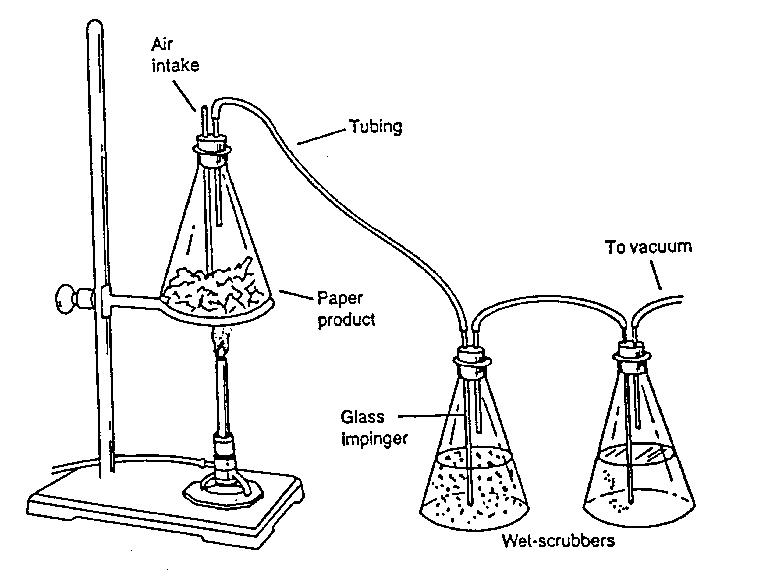How to Make a Wet Scrubber
Purpose:
To become familiar with a wet scrubber by building and using one.
Materials:
paper towels
12-cm piece of glass tubing
three 2.5-cm pieces of glass tubing
three 55-ml flasks
two glass impingers (glass tubing drawn at one end to give it a smaller
diameter so as to let out smaller bubbles)
heat source (burner or hot plate)
three 2-hole rubber stoppers (of a size to fit the mouths of the flasks)
two 30-cm pieces of rubber tubing
ringstand apparatus
vacuum source
Background information:
The wet scrubber is one of the most common pollution control devices used
by industry. It operates on a very simple principle: a polluted gas stream
is brought into contact with a liquid so that the pollutants can be absorbed.
Procedure:

-
Set up the apparatus as shown above. Put a paper towel in a 55-ml flask
and place this above the burner.
-
Using a 2-hole stopper that makes an air-tight seal with the flask, insert
a 12-cm section of glass tubing through one of the holes. The tubing should
reach to approximately 1.2-cm from the bottom of the flask.
-
Insert a 2.5-cm piece of glass tubing into the other hole of the stopper.
-
Connect a 30-cm piece of rubber tubing to the 2.5-cm piece of glass tubing,
making sure an air-tight seal exists.
-
Fill a second 500-ml flask approximately 3/4 full of water. Using a second
double-hole stopper, put a 2.5-cm piece of glass tubing into one of the
holes, and insert the glass impinger into the other.
-
Construct a third flask like the second.
-
Connect the rubber tubing and heat the first flask (combustion chamber)
until smoke appears.
-
Put a vacuum on the third flask to draw a stream of smoke through the second
flask (the wet scrubber). If smoke collects in the second flask above the
water, a second scrubber can be added.
-
Ask the students if particles are the only pollutants produced by industry.
Discuss how a wet scrubber collects not only particulate matter but also
captures waste gases. Demonstrate how the water scrubber works. Discuss
that the white plume you see coming from a smokestack may really be steam
coming from a water scrubber.
Use these questions
to help in observation.
Why does the water in the wet-scrubber change color?
Why does the wet-scrubber have an impinger (in other words, why
is it important for small bubbles to be formed)?
What does the scrubber filter out of the air? Not filter out?
Suggest ways to dispose of the pollutants that are now trapped
in the water.

